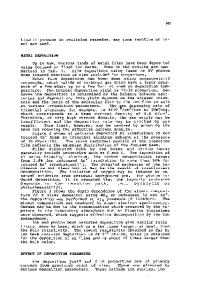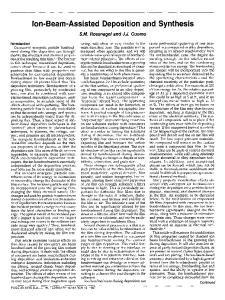Ion Beam Assisted Deposition
- PDF / 445,585 Bytes
- 11 Pages / 612 x 792 pts (letter) Page_size
- 17 Downloads / 411 Views
R12.5.1
ION BEAM ASSISTED DEPOSITION James K. Hirvonen AMSRD-ARL-WM-MA US Army Research Laboratory Aberdeen Proving Ground, MD 21005 ABSTRACT The beneficial roles energetic ions play in thin film vacuum processes have long been recognized by the vacuum coating community. Optical coaters were among the first to adopt the process in the form of concurrent, low energy, directed ion beam bombardment of physical vapor deposition [electron beam] coatings for producing dense, adherent, robust, and environmentally resistant optical coatings. The international research and development community has also been actively pursuing the study of ion beam assisted deposition (IBAD) for both studying the mechanisms of ion/solid interactions during thin film growth as well as for developing coating protocols for specific application areas, including: tribological coatings, anti-corrosion coatings, optical coatings, superconducting buffer layers and coatings for temperature sensitive substrates such as polymers. This paper will review selected areas of this active field and will attempt to identify emerging application areas. FEATURES OF IBAD PROCESSING The beneficial roles energetic ions play in thin film vacuum processes (Figure 1, Table I) have been recognized by the vacuum coating community since the 1960s [1]. Mattox’s 1970s patent described the benefits in the ion plating process. Optical coaters such as Martin et al. [2] utilizing electron beam evaporation found that the densification of coatings produced with ion assistance during deposition produced a compact pore-free coating that eliminated the pickup of water from the atmosphere, and the strong and deleterious optical shifts that absorbed water produces in the open columnar microstructures that often prevail in low temperature e-beam depositions. Independent vacuum deposition coincident with energetic ion bombardment became practical with the availability of high current broad beam ion sources in the 1970s. This also allowed the independent control of ion energies and the relative arrival rates of ions and evaporated or sputter deposited atoms to be measured and their effects to be determined. Table I: Features of IBAD process
Figure 1. Schematic of IBAD process
1) Generic effects on thin film growth • Enhanced adhesion • Nucleation • Densification • Texture modification • Stress control • Surface morphology & patterning 2) Chemical effects on growth • Stoichiometry & synthesis control
R12.5.2
Effects of ions on film growth During IBAD processing, the atom (neutral) species are produced via physical vapor deposition, normally evaporation or sputtering. The energetic ion beam assisting the deposition is typically produced by a low energy (0.1-2.0 keV) broad beam ion source capable of beam current densities of up to 1-2 mA/cm2 (circa 1016 atoms/cm2/s). The ratio of the ion beam current to the neutral atom flux, termed Ra, or sometimes the product of Ra and the ion energy E, are often used as parameters in IBAD studies as a means of quantifying film properties. In generi
Data Loading...











